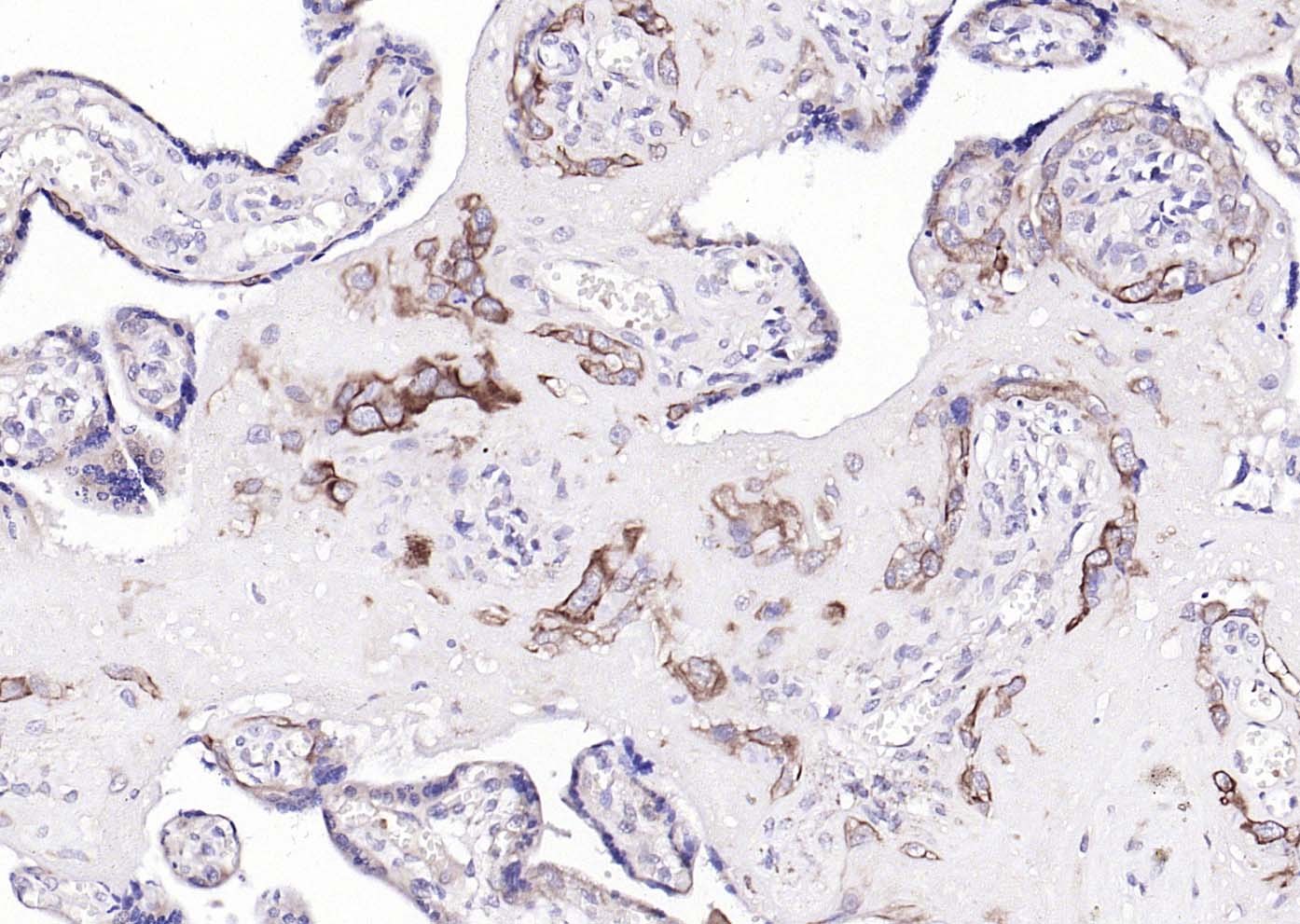STRA6 Rabbit pAb
STRA6 Rabbit pAb
- 产品详情
- 实验流程
- 背景知识
Application
| IHC-P, IHC-F, IF |
|---|---|
| Primary Accession | Q9BX79 |
| Reactivity | Rat, Dog, Horse |
| Host | Rabbit |
| Clonality | Polyclonal |
| Calculated MW | 73503 Da |
| Physical State | Liquid |
| Immunogen | KLH conjugated synthetic peptide derived from Human STRA6 |
| Epitope Specificity | 151-250/667 |
| Isotype | IgG |
| Purity | affinity purified by Protein A |
| Buffer | 0.01M TBS (pH7.4) with 1% BSA, 0.02% Proclin300 and 50% Glycerol. |
| SUBCELLULAR LOCATION | Cell membrane; multi-pass membrane protein. |
| DISEASE | Defects in STRA6 are the cause of microphthalmia syndromic type 9 (MCOPS9) [MIM:601186]; also called Matthew-Wood syndrome or Spear syndrome. Microphthalmia is a clinically heterogeneous disorder of eye formation, ranging from small size of a single eye to complete bilateral absence of ocular tissues (anophthalmia). In many cases, microphthalmia/anophthalmia occurs in association with syndromes that include non-ocular abnormalities. MCOPS9 is a rare clinical entity including as main characteristics anophthalmia or severe microphthalmia, and pulmonary hypoplasia or aplasia. Note=Mutations in STRA6 may be a cause of isolated colobomatous microphthalmia, a disorder of the eye characterized by an abnormally small ocular globe. |
| Important Note | This product as supplied is intended for research use only, not for use in human, therapeutic or diagnostic applications. |
| Background Descriptions | STRA6 is a 667 amino acid, multi-pass cell membrane protein. Stra6 functions as a cell-surface receptor for the complex retinol-retinol binding protein (RBP/RBP4). Ultimately increasing cellular retinol uptake from the retinol-RBP complex, Stra6 removes retinol from RBP/RPB4 and transports it across the plasma membrane, where it is metabolized. Stra6 is broadly expressed, with 4 named isoforms that exist as a result of alternative splicing events. Mutations in the gene encoding Stra6 cause Matthew-Wood Syndrome, also known as Spear Syndrome. This syndrome is characterized by anophtalmia, mild facial dysmorphism and malformations of the heart, lung and diaphragm. The Stra6 gene maps to chromosome 15q24.1. |
| Gene ID | 64220 |
|---|---|
| Other Names | Receptor for retinol uptake STRA6, Retinol-binding protein receptor STRA6, Stimulated by retinoic acid gene 6 protein homolog, STRA6 |
| Target/Specificity | Broad expression. In adult eye expressed in sclera, retina, retinal pigment epithelium, and trabecular meshwork but not in choroid and iris. |
| Dilution | IHC-P=1:100-500,IHC-F=1:100-500,IF=1:100-500 |
| Storage | Store at -20 °C for one year. Avoid repeated freeze/thaw cycles. When reconstituted in sterile pH 7.4 0.01M PBS or diluent of antibody the antibody is stable for at least two weeks at 2-4 °C. |
| Name | STRA6 |
|---|---|
| Function | Functions as a retinol transporter. Accepts all-trans retinol from the extracellular retinol-binding protein RBP4, facilitates retinol transport across the cell membrane, and then transfers retinol to the cytoplasmic retinol-binding protein RBP1 (PubMed:18316031, PubMed:22665496, PubMed:9452451). Retinol uptake is enhanced by LRAT, an enzyme that converts retinol to all-trans retinyl esters, the storage forms of vitamin A (PubMed:18316031, PubMed:22665496). Contributes to the activation of a signaling cascade that depends on retinol transport and LRAT-dependent generation of retinol metabolites that then trigger activation of JAK2 and its target STAT5, and ultimately increase the expression of SOCS3 and inhibit cellular responses to insulin (PubMed:21368206, PubMed:22665496). Important for the homeostasis of vitamin A and its derivatives, such as retinoic acid (PubMed:18316031). STRA6-mediated transport is particularly important in the eye, and under conditions of dietary vitamin A deficiency (Probable). Does not transport retinoic acid (PubMed:18316031). |
| Cellular Location | Cell membrane; Multi-pass membrane protein. Note=In the retinal pigment epithelium localizes to the basolateral membrane. {ECO:0000250|UniProtKB:Q0V8E7} |
| Tissue Location | Broad expression. In adult eye expressed in sclera, retina, retinal pigment epithelium, and trabecular meshwork but not in choroid and iris. |
For Research Use Only. Not For Use In Diagnostic Procedures.
Provided below are standard protocols that you may find useful for product applications.
BACKGROUND
STRA6 is a 667 amino acid, multi-pass cell membrane protein. Stra6 functions as a cell-surface receptor for the complex retinol-retinol binding protein (RBP/RBP4). Ultimately increasing cellular retinol uptake from the retinol-RBP complex, Stra6 removes retinol from RBP/RPB4 and transports it across the plasma membrane, where it is metabolized. Stra6 is broadly expressed, with 4 named isoforms that exist as a result of alternative splicing events. Mutations in the gene encoding Stra6 cause Matthew-Wood Syndrome, also known as Spear Syndrome. This syndrome is characterized by anophtalmia, mild facial dysmorphism and malformations of the heart, lung and diaphragm. The Stra6 gene maps to chromosome 15q24.1.
终于等到您。ABCEPTA(百远生物)抗体产品。
点击下方“我要评价 ”按钮提交您的反馈信息,您的反馈和评价是我们最宝贵的财富之一,
我们将在1-3个工作日内处理您的反馈信息。
如有疑问,联系:0512-88856768 tech-china@abcepta.com.























 癌症的基本特征包括细胞增殖、血管生成、迁移、凋亡逃避机制和细胞永生等。找到癌症发生过程中这些通路的关键标记物和对应的抗体用于检测至关重要。
癌症的基本特征包括细胞增殖、血管生成、迁移、凋亡逃避机制和细胞永生等。找到癌症发生过程中这些通路的关键标记物和对应的抗体用于检测至关重要。 为您推荐一个泛素化位点预测神器——泛素化分析工具,可以为您的蛋白的泛素化位点作出预测和评分。
为您推荐一个泛素化位点预测神器——泛素化分析工具,可以为您的蛋白的泛素化位点作出预测和评分。 细胞自噬受体图形绘图工具为你的蛋白的细胞受体结合位点作出预测和评分,识别结合到自噬通路中的蛋白是非常重要的,便于让我们理解自噬在正常生理、病理过程中的作用,如发育、细胞分化、神经退化性疾病、压力条件下、感染和癌症。
细胞自噬受体图形绘图工具为你的蛋白的细胞受体结合位点作出预测和评分,识别结合到自噬通路中的蛋白是非常重要的,便于让我们理解自噬在正常生理、病理过程中的作用,如发育、细胞分化、神经退化性疾病、压力条件下、感染和癌症。






